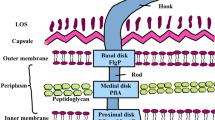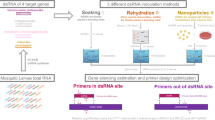Abstract
Polyether ionophores are widely used to treat and control coccidiosis in chickens. Widespread use of anticoccidials resulted in worldwide resistance. Mechanisms of resistance development and expansion are complex and poorly understood. Relative proteomic quantification using LC-MS/MS was used to compare sensitive reference strains (Ref-1, Ref-2) with putatively resistant and moderately sensitive field strains (FS-R, FS-mS) of Eimeria tenella after isotopic labelling with tandem mass tags (TMT). Ninety-seven proteins were identified, and 25 of them were regulated. Actin was significantly upregulated in resistant strains in comparison with their sensitive counterparts. On the other hand, microneme protein (MIC4) was downregulated in resistant strains. Optimization of labelling E. tenella sporozoites by TMT might identify further proteins that play a role in the obvious complex mechanism leading to resistance against Monensin.

Similar content being viewed by others
References
Chapman H, Jeffers K, Williams R (2010) Forty years of monensin for control of coccidiosis in poultry. Poult Sci 89:1788–1801
Chen T, Zhang W, Wang J, Dong H, Wang M (2008) Eimeria tenella: analysis of differentially expressed genes in the monensin- and maduramicin-resistant lines using cDNA array. Exp Parasitol 119:264–271
Del Carmen MG, Mondragón M, González S, Mondragón R (2009) Induction and regulation of conoid extrusion in Toxoplasma gondii. Cell Microbiol 11:967–982
Hotulainen P, Paunola E, Vartiainen M, Lappalainen P (2005) Actin-depolymerizing factor and cofilin-1 play overlapping roles in promoting rapid F-actin depolymerization in mammalien nonmuscle cells. Mol Biol Cell 16:649–664
Jean L, Grosclaude J, Labbé M, Tomley F, Péry P (2000) Differential localisation of an Eimeria tenella aspartyl proteinase during the infection process. Int J Parasitol 30(10):1099–1107
Kuhn K, Baumann C, Tommassen J, Prinz T (2012) TMT labelling for the quantitative analysis of adaptive responses in the meningococcal proteome. Methods Mol Biol 799:127–141
Labbé M, Venevelles P, Girard-Misguich F, Bourdieu C, Guillamue A, Péry P (2005) Eimeria tenella microneme protein EtMIC3 : identification, localisation and role in host cell infection. Mol Biochem Parasitol 140:43–53
Labbé M, Péroval M, Boudieu C, Girard-Misguich F, Péry P (2006) Eimeria tenella enolase and pyruvate kinase: a likely role in glycolysis and in other functions. Int J Parasitol 36:1443–1452
Lal K, Bromley E, Oakes R, Prieto J, Sanderson S, Kurian D, Hunt L, Yates JR, Wastling J, Sinden R, Tomley F (2009) Proteomic comparison of four Eimeria tenella life-cycle stages: unsporulated oocyst, sporulated oocyst, sporozoite and second-generation merozoite. Proteomics 9:4566–4576
Mattig F, Drössigk U, Entzeroth R (1993) A simple method for the purification of Eimeria tenella sporozoites. Appl Parasitol 34:139–142
McDougald L, Fitz-Coy S (2013) Coccidiosis: protozoal infections. In: Swayne DE (ed) Diseases of poultry, 13th edn. Blackwell, New York, pp 1148–1166
Mehta S, Sibley L (2011) Actin depolymerizing factor controls actin turnover and gliding motility in Toxoplasma gondii. Mol Biol Cell 22:1290–1299
Peek H, Landman W (2003) Resistance to anticoccidial drugs of Dutch avian Eimeria spp. field isolates originating from 1996, 1999 and 2001. Avian Pathol 32:391–401
Periz J, Gill A, Hunt L, Brown P, Tomley F (2007) The microneme proteins EtMIC4 and EtMIC5 of Eimeria tenella form a novel, ultra-high molecular mass protein complex that binds target host cells. J Biol Chem 282:16891–16898
Raether W, Hofmann J, Uphoff M (1995) In vitro cultivation of avian Eimeria species: Eimeria tenella. In: Eckert J, Braun R, Shirley M, Coudert P (eds) Biotechnology guidelines on techniques in coccidiosis. European Commission, Brussel, pp 79–92
Stephan B, Rommel M, Daugschies A, Haberkorn A (1997) Studies of resistance to anticoccidial in Eimeria field isolates and pure Eimeria strains. Vet Parasitol 69:19–29
Thabet A, Zhang R, Alnassan A, Daugschies A, Bangoura B (2017a) Anticoccidial efficacy testing: In vitro Eimeria tenella assays as replacement for animal experiments. Vet Parasitol 233:86–96
Thabet, A., Schmidt, J., Baumann, S., Honscha, W., von Bergen, M., Daugschies, A., Bangoura B (2017b) Resistance toward monensin is acquired in a Toxoplasma gondii model by reduced invasion and egress activities, in addition to increased intracellular replication. In press
Tomley F, Billington K, Bumstead J, Clark J, Monaghan P (2001) EtMIC4: a microneme protein from Eimeria tenella that contains tandem arrays of epidermal growth factor-like repeats and thrombospondin type-I repeats. Int J Parasitol 31:1303–1310
Acknowledgments
The authors would like to thank Helmholz Centre for Environmental Research (UFZ), particularly Prof. Martin von Bergen, Dr. Sven Baumann, and Johannes Schmidt for their technical support and advice. We thank also Prof. Damer Blake (The Royal Veterinary Colleges; University of London) and Dr. Alberta Lorraine Fuller (College of Agricultural and Environmental Science, The University of Georgia) for providing reference and field E. tenella strains. We would like to thank DAAD (German Academic Exchange Service) for supporting Ahmed Thabet.
Author information
Authors and Affiliations
Corresponding author
Ethics declarations
Conflict of interest
The authors declare that they have no conflict of interest.
Electronic supplementary material
ESM 1
(XLSX 147 kb)
Rights and permissions
About this article
Cite this article
Thabet, A., Honscha, W., Daugschies, A. et al. Quantitative proteomic studies in resistance mechanisms of Eimeria tenella against polyether ionophores. Parasitol Res 116, 1553–1559 (2017). https://doi.org/10.1007/s00436-017-5432-z
Received:
Accepted:
Published:
Issue Date:
DOI: https://doi.org/10.1007/s00436-017-5432-z




